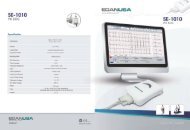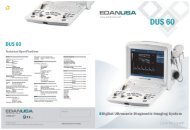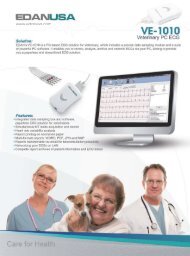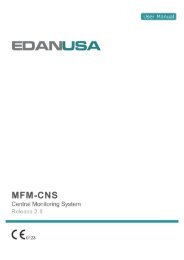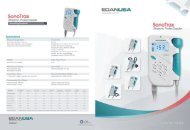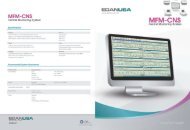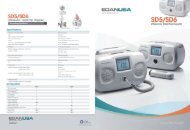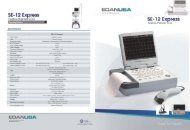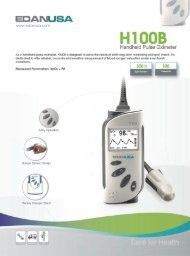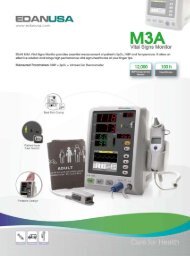Manual - EDAN USA
Manual - EDAN USA
Manual - EDAN USA
You also want an ePaper? Increase the reach of your titles
YUMPU automatically turns print PDFs into web optimized ePapers that Google loves.
About this <strong>Manual</strong>P/N: 21.54.109000-15Release Date: Dec 2010© Copyright <strong>EDAN</strong> INSTRUMENTS, INC. 2007-2010.All rights reserved.StatementThis manual will help you understand the operation andmaintenance of the product better. It is reminded that theproduct shall be used strictly complying with this manual.User’s operation failing to comply with this manual mayresult in malfunction or accident for which <strong>EDAN</strong>INSTRUMENTS, INC. (hereinafter called <strong>EDAN</strong>) cannot be held liable.<strong>EDAN</strong> owns the copyrights of this manual. Withoutprior written consent of <strong>EDAN</strong>, any materials containedin this manual shall not be photocopied, reproduced ortranslated into other languages.Materials protected by the copyright law, including butnot limited to confidential information such as technicalinformation and patent information are contained in thisI
manual, the user shall not disclose such information toany irrelevant third party.The user shall understand that nothing in this manualgrants him, expressly or implicitly, any right or license touse any of the intellectual properties of <strong>EDAN</strong>.<strong>EDAN</strong> holds the rights to modify, update, and ultimatelyexplain this manual.Responsibility of theManufacturer<strong>EDAN</strong> only considers itself responsible for any effect onsafety, reliability and performance of the equipment if:Assembly operations, extensions, re-adjustments,modifications or repairs are carried out by personsauthorized by <strong>EDAN</strong>, andThe electrical installation of the relevant room complieswith national standards, andThe instrument is used in accordance with theinstructions for use.Upon request, <strong>EDAN</strong> may provide, with compensation,necessary circuit diagrams, and other information to helpII
qualified technician to maintain and repair some parts,which <strong>EDAN</strong> may define as user serviceable.Terms Used in this <strong>Manual</strong>This guide is designed to give key concepts on safetyprecautions.WARNINGA WARNING label advises against certain actions orsituations that could result in personal injury or death.CAUTIONA CAUTION label advises against actions or situationsthat could damage equipment, produce inaccurate data,or invalidate a procedure.NOTEA NOTE provides useful information regarding afunction or a procedure.III
Table of Contents1 Safety Information .................................................11.1 Warnings ...........................................................11.2 Cautions ............................................................71.3 Notes.................................................................91.4 Symbols in the Oximeter................................. 112 Introduction ..........................................................142.1 General Introduction........................................142.2 Panel Introduction ...........................................152.2.1 Symbols on Screen ..................................162.2.2 Front Panel Buttons..................................182.2.3 Rear Panel ...............................................222.3 Connecting Sensor or Cable...........................232.4 Powered by Battery.........................................242.5 Accessory List .................................................273 Oximeter Operation .............................................313.1 Turning on the Oximeter .................................313.2 Measurement State.........................................323.2.1 Measurement Modes................................323.2.2 Trend Graph and Trend Table .................333.2.3 Abnormal Measurement State .................343.2.4 Data Transfer State..................................35IV
3.3 System Menu ..................................................363.3.1 System Mode ...........................................383.3.2 Patient Type .............................................393.3.3 Alarm Volume...........................................393.3.4 Pulse Volume ...........................................393.3.5 Audio Paused (s)......................................403.3.6 User Maintain ...........................................403.3.7 Default Config...........................................413.3.8 Sensitivity .................................................423.3.9 Alarm System ...........................................423.3.10 SpO 2 Alarm setup...................................443.3.11 PR Alarm setup ......................................463.3.12 Patient ID No. Setup...............................473.3.13 Data Storage ..........................................483.3.14 Delete All Data .......................................493.3.15 Exit (Return) ...........................................503.4 Charging the Ni-MH Battery Package.............503.5 PatientCare Viewer Data Management SoftwareIntroduction ...........................................................514 Alarm .....................................................................524.1 Alarm Categories and Levels..........................524.2 Alarm Conditions.............................................54V
4.2.1 Alarm off Before the First Measurement ..544.2.2 Alarm for SpO2 Sensor Unconnected......554.2.3 Alarm for SpO2 Sensor off .......................554.2.4 Alarm for Low Battery...............................554.2.5 Higher than Hi Alarm Limit .......................564.2.6 Lower than Lo Alarm Limit .......................564.2.7 Alarm Silence ...........................................574.2.8 Turning off Alarm System.........................574.2.9 Alarm Priority............................................575 Performance Considerations..............................585.1 Performance Verification.................................585.2 Oximeter Performance Considerations...........585.3 Sensor Performance Considerations..............596 Maintenance .........................................................637 Principles of Operation .......................................667.1 Pulse Oximetry Measurement.........................677.2 Functional Versus Fractional Saturation.........697.3 Measured Versus Calculated Saturation ........708 Warranty and Service Policy...............................718.1 Warranty..........................................................718.2 Service Policy..................................................72AppendixⅠSpecification........................................74VI
A1.1 Classification.................................................74A1.2 Specification .................................................74A1.2.1 Size and Weight.....................................74A1.2.2 Environment...........................................74A1.2.3 Display ...................................................75A1.2.4 Batteries .................................................75A1.2.5 Charger Stand........................................76A1.3 Parameters ...................................................76Appendix II EMC Information.................................78A2.1 Electromagnetic Emissions - for allEQUIPMENT and SYSTEMS................................78A2.2 Electromagnetic Immunity - for allEQUIPMENT and SYSTEMS................................80A2.3 Electromagnetic emissions-for EQUIPMENTand SYSTEMS that are not LIFE-SUPPORTING.83A2.4 Recommended Separation Distances..........87Appendix Ⅲ Record Table....................................89Appendix Ⅳ Abbreviations ..................................90VII
H100B Pulse Oximeter User <strong>Manual</strong>1 Safety Information1.1 WarningsWarnings are identified by the WARNING symbolshown above.A WARNING label advises against certain actionsor situations that could result in personal injury ordeath.WARNING1 Avoid explosion hazard. Do not use theoximeter in the presence of flammableanesthetic mixtures with air, or with oxygen ornitrous oxide.2 Chemicals from a broken LCD display panel aretoxic when ingested. Use cautions when theoximeter has a broken display panel.3 Routinely monitor the patient to make sure theoximeter is functioning and the sensor iscorrectly placed.4 Oximetry measurements and pulse signals canbe affected by certain environmental conditions,- 1 -
H100B Pulse Oximeter User <strong>Manual</strong>sensor application errors, and certain patientconditions.5 The use of accessories, sensors, and cablesother than those specified may result inincreased emission of electromagnetic radiationand/or invalid readings of the oximeter.6 Failure to cover the sensor site with opaquematerial in high ambient light conditions mayresult in inaccurate measurements.7 Do not silence the audio alarm function, ordecrease the audio alarm volume, if patientsafety could be compromised.8 The oximeter is a prescription device to beoperated only by trained personnel. Theoximeter is for attended monitoring only.9 Dispose of batteries in accordance with localordinances and regulations.10 The oximeter is not defibrillator-proof. However,it may remain attached to the patient throughoutdefibrillation or while an electrosurgical unit is inuse. The measurements may be inaccuratethroughout the defibrillation, or use of an- 2 -
H100B Pulse Oximeter User <strong>Manual</strong>electrosurgical unit, and shortly thereafter. Toavoid shock, the caregiver should not hold theoximeter while using a defibrillator on a patient.11 Disconnect the oximeter and sensor from thepatient throughout magnetic resonance imaging(MRI) scanning. Induced current couldpotentially cause burns.12 To ensure accurate performance and preventdevice failure, do not subject the oximeter toextreme moisture, such as direct exposure torain. Such exposure may cause inaccurateperformance or device failure.13 Do not lift the oximeter by the sensor orextension cable because the cable coulddisconnect from the oximeter and the oximetermay drop on the patient.14 Do not make any clinical judgment based solelyon the oximeter, it is intended only as anadjunct in patient assessment. It must be usedin conjunction with clinical signs and symptoms.15 To ensure patient safety, do not place theoximeter in any position that might cause it to- 3 -
H100B Pulse Oximeter User <strong>Manual</strong>fall on the patient.16 As with all medical equipment, carefully routepatient cables to reduce the possibility ofpatient entanglement or strangulation.17 Ensure that the speaker is clear of anyobstruction and that the speaker holes are notcovered. Failure to do so could result in aninaudible alarm tone.18 Use only <strong>EDAN</strong> permitted sensors andextension cables with the oximeter. Othersensors or extension cables may fail and/orcause improper monitor performance and/orminor personal injury.19 H100B Pulse Oximeter readings and pulsesignals can be affected by certain ambientenvironmental conditions, sensor applicationerror, and certain patient conditions. See theappropriate sections of the manual for specificsafety information.20 Don’t mix new and old batteries together. Don’tmix rechargeable batteries with alkalinebatteries.- 4 -
H100B Pulse Oximeter User <strong>Manual</strong>21 Periodically check the battery for corrosion.Remove the batteries from the oximeter if youdo not expect to use it within one month.22 The device enters POST (Power-On-Self-Test)immediately after power-on to confirm all thedisplay segments and icons are shown and thespeaker sounds a few seconds tone. If you donot hear the POST pass tone, it indicates thealarm system does not work well. Please do notuse the H100B Pulse Oximeter and contactqualified service personnel or your local <strong>EDAN</strong>representative.23 Before using it, the user should carefully readthe applicable user manual of sensor, includingwarnings, cautions and instructions.24 Do not use damaged sensor or extensioncables, do not use sensor with exposed opticalcomponents.25 Tissue damage may be caused by incorrectapplication or prolonged measurement durationusing the sensor (more than 2 hours). Inspectthe sensor periodically according to sensor user- 5 -
H100B Pulse Oximeter User <strong>Manual</strong>manual.26 Do not immerse or wet the sensor, as this maydamage the sensor.27 There are no user-serviceable parts inside theoximeter, the cover should only be removed byqualified service personnel.28 Do not spray, pour, spill liquid to the oximeterand its accessories, connector, switch oropening in enclosure, as this may damage theoximeter.29 Before cleaning the oximeter or the sensor,make sure that the equipment is switched offand disconnected from the power line.30 Do not use the charger stand when the alkalinebattery is depleted or no battery is installed.31 Do not monitor the patient while the battery isbeing charged.32 Do not disassemble batteries, or dispose ofthem in fire, or cause them to short circuit. Theymay ignite, explode, leak, or cause personalinjury.33 Only use <strong>EDAN</strong> approved rechargeable- 6 -
H100B Pulse Oximeter User <strong>Manual</strong>batteries and charger stand for H100B pulseoximeter.34 A potential hazard can exist if different alarmpresets are used.35 This equipment is not intended for family usage.1.2 CautionsCautions are identified by the CAUTION symbolshown above.Cautions alert the user to exercise care necessaryfor the safe and effective use of the oximeter.CAUTION1 All combinations of equipment must be incompliance with IEC/EN Standard 60601-1-1systems requirements.2 The device and accessories are to be disposedof according to local regulations after theiruseful lives. Alternatively, they can be returnedto the dealer or the manufacturer for recyclingor proper disposal. Batteries are hazardous- 7 -
H100B Pulse Oximeter User <strong>Manual</strong>waste. Do NOT dispose them together withhouse-hold garbage. At the end of their lifehand the batteries over to the applicablecollection points for the recycling of wastebatteries. For more detailed information aboutrecycling of this product or battery, pleasecontact your local Civic Office, or the shopwhere you purchased the product.3 H100B Pulse Oximeter will not operate withdead batteries. Install new batteries.4 The sensor unconnected icon and associatedalarm indicate the sensor has disconnected orwire fault. So check the sensor connection and,if necessary, replace the sensor, extensioncables or both.5 When adjusting any menu parameters, theoximeter does not display SpO 2 or PR, but it isstill recording.6 Do not run the pulse oximeter when alkalinebatteries of different types are used at the sametime.7 Federal (U.S.) Law restricts this device to sale- 8 -
H100B Pulse Oximeter User <strong>Manual</strong>by or on the order of a physician.1.3 NotesNOTE:Notes are identified by the symbol shown above.Notes contain important information that may beoverlooked or missed.NOTE:1 This device has been tested and found tocomply with the limits for medical device inIEC/EN60601-1-2 (International standard forEMC testing of Medical Electrical Equipment,second edition). These limits are designed toprovide reasonable protection against harmfulinterference in a typical medical installation.2 Sensor LED light emissions fall within Class 1level, according to IEC/EN 60825-1:2001. Nospecial safety precautions are required.3 Normal operation means:• The oximeter is turned on;• A sensor is connected to the oximeter;- 9 -
H100B Pulse Oximeter User <strong>Manual</strong>• The sensor is applied to the patient;• The patient’s SpO 2 , Pulse rate are beingreported;• No error conditions exist.4 Wash the probe with clean water afterdisinfecting it to remove any remaining solution.The probe can only be reused after driedthoroughly.5 Do not disinfect the probe with the water boiled.6 Any residue should be removed from the probebefore being disinfected, and avoid contactingcorrosive solvent. Dipping the cable into alcoholor alkalescent solvent for a long time mayreduce the flexibility of the scarfskin of the cable.Also, the connector should not be dipped.7 After monitoring, disinfect the probe accordingto the instruction described in the user manual.8 The materials with which the patient or anyother person can come into contact conformwith the standard of ISO10993.9 The pictures and interfaces in this manual arefor reference only.- 10 -
H100B Pulse Oximeter User <strong>Manual</strong>10 A functional tester cannot be used to assessthe accuracy of the pulse oximeter probe or thepulse oximeter monitor.11 If there is independent demonstration that theparticular calibration curve is accurate for thecombination of a pulse oximeter monitor and apulse oximeter probe, then a functional testercan measure the contribution of a monitor to thetotal error of a monitor/probe system. Thefunctional tester can then measure howaccurately a particular pulse oximeter monitor isreproducing that calibration curve.12 The operating time of the Ni-MH rechargeablebattery package depends on the configurationand operation of the pulse oximeter.1.4 Symbols in the OximeterThis symbol indicates that theinstrument is IEC/EN 60601-1Type BF equipment.- 11 -
H100B Pulse Oximeter User <strong>Manual</strong>The symbol indicates that the deviceshould be sent to the special agenciesaccording to local regulations forseparate collection after its useful life.Federal (U.S.) Law restricts thisdevice to sale by or on the order of aphysician.Auxiliary output connectorRecycleMEDICAL EQUIPMENT WITHRESPECT TO ELECTRICALSHOCK, FIRE ANDMECHANICAL HAZARDSONLY IN ACCORDANCE WITHUL60601-1 and CAN / CSA C22.2No. 601.1.- 13 -
H100B Pulse Oximeter User <strong>Manual</strong>2 IntroductionIntended UseThe oximeter is intended for continuous monitoring orspot-checking of functional arterial oxygen saturation(SpO 2 ) and pulse rate of adult, pediatric or neonatalpatients in hospitals, intra-hospital transport and hospitalgrade facilities.2.1 General IntroductionH100B Pulse Oximeter (hereinafter called oximeter) isone model of H100 series Pulse Oximeter. It displaysSpO 2 value, pulse rate value, plethysmogram, bar graph,etc.The oximeter is installed with <strong>EDAN</strong> SpO 2 moduleinside. It integrates parameter module, display andrecorder output functions. It can be powered by four1.5V AA batteries or one Ni-MH rechargeable AAbattery package. It can clearly display all the parameterinformation on LCD.- 14 -
H100B Pulse Oximeter User <strong>Manual</strong>Figure 2-1 H100B Pulse OximeterFor the oximeter, Oximeter Viewer Data ManagementSoftware is optional.2.2 Panel IntroductionThis section identifies the symbols, controls, displays,and buttons on the front panel of the oximeter and therear panel.- 15 -
H100B Pulse Oximeter User <strong>Manual</strong>2.2.1 Symbols on ScreenFigure 2-2 Waveform ModeFigure 2-3 Large Numeric ModeIcons on the screen and their meanings:SpO 2 SpO 2 value display area100% Measured SpO 2 %PR Pulse Rate value display area60 bpm Measured Pulse rate (bpm)Displays when measurement valueis higher than the upper alarm limitDisplays when measurementvalue is lower than the lower alarmlimit- 16 -
H100B Pulse Oximeter User <strong>Manual</strong>SpO 2 waveform displayPulse amplitude displayLow battery iconAudio alarm off iconAlarm off iconData storage icon04: 59 Time display in Information area:“hour: minute”ADU/NEO Patient type in Information area:Adult or Neonate.ID: 99 Patient ID in Information areaSpO 2 sensor unconnected iconSpO 2 sensor offIndicates the memory space is full- 17 -
H100B Pulse Oximeter User <strong>Manual</strong>Weak signal iconNOTE:1 The icons for sensor unconnected, sensor off orweak signal are displayed on the right ofInformation area. Only one of them can bedisplayed at a time.2 The ID icon and the icon that indicates thememory space is full are displayed in theInformation Area. Only one icon can bedisplayed at a time.2.2.2 Front Panel ButtonsThis section describes the buttons on the front panel ofthe oximeter. The controls are activated by pressing thebutton that corresponds to that control. For example,press the Alarm Silence button to control the audioalarm.- 18 -
or off the backlight.H100B Pulse Oximeter User <strong>Manual</strong>Alarm Silence ButtonAlarms that occur during the Power-On-Self-Test (POST)can not be silenced.When Alarm System in menu is setup to ON, pressingthe Alarm Silence button can turn off the audio alarm.The pause period can be set to 30, 60, 90 or 120 seconds.Although the audio alarm is off, the visual alarm is stillactive. After the pause period is over, the audio alarm isreactivated.Set Alarm System to OFF in the menu to turn off thealarm. A Pop-up dialog box will display to confirm alarmsetting. See details in 3.3.8.Up Arrow ButtonIn the menu state, press the Up Arrow button to choosedifferent items, and increase the value of someparameters. Press it repeatedly to make a parameterincrease by more than one. Press and hold this button formore than one second to repeat the incrementcontinuously.Press this button in measurement state to enter the latest- 20 -
H100B Pulse Oximeter User <strong>Manual</strong>10-minute SpO 2 or PR trend graph.Down Arrow ButtonIn the menu state, pressing the Down Arrow button canchoose different items, and decrease the value of someparameters. Press it repeatedly to make a parameterdecrease by more than one. Press and hold the button formore than one second to repeat the decrementcontinuously.Press this button in measurement state to enter the latest10-minute SpO 2 and PR trend table.Function ButtonDuring the POST, the Function button is not available;Press this button in normal measurement state to enterfunction choice or setup menu;In the menu state, this button is also used as the Enterbutton. Choose one item in menu using the cursor button(the Up Arrow button and the Down Arrow button), andpress the Function button to confirm, then increase ordecrease the value using cursor button.When the oximeter is off, synchronously press theOn/Off button and the Function button for one second,- 21 -
H100B Pulse Oximeter User <strong>Manual</strong>the oximeter will enter data transfer state.Button CombinationWhen the oximeter is off, synchronously press theOn/Off button and the Function button for one second,the oximeter will enter Data transfer state.2.2.3 Rear PanelFigure 2-5 Rear Panel- 22 -
H100B Pulse Oximeter User <strong>Manual</strong>2.3 Connecting Sensor or CableFigure 2-6 Sensor and Cable Connecting PortSpO 2 Sensor and cable port is at the top of the oximeter.An extension cable can be used between the oximeterand the SpO 2 sensor. Use only the cable permitted by<strong>EDAN</strong>.The cable for connecting the oximeter and PC with theOximeter Viewer Data Management Software is alsoconnected to this port.Type BF applied partAuxiliary output connectorSIO definition:PIN Name Description- 23 -
H100B Pulse Oximeter User <strong>Manual</strong>1 RSGND The RS232 GND2 LED+ LED drive signal, IR Anode3 LED- LED drive signal, RedAnode4 RXD H100 RS232 RX5 Detector Anode Detector anode6 Connection Detector connection7 AGND Analog GND8 TXD H100 RS232 TX9 Detector Cathode Detector cathode2.4 Powered by BatteryThe oximeter can be powered by four 1.5V LR6 AAalkaline batteries. It will operate for 48 hours when usedfor general operation, or about 24 hours of operationwith the backlight and alarm on.The oximeter can also be powered by the Ni-MHrechargeable battery package.Battery InstallationTo install the alkaline batteries:1. Make sure the oximeter is turned off.2. Press the battery compartment latch and- 24 -
H100B Pulse Oximeter User <strong>Manual</strong>remove the battery access door.3. Place four AA batteries as shown in thefollowing figure, first push it oriented asshown in 1, then press it oriented as shownin 2.4. Install the battery compartment cover.To install the Ni-MH rechargeable battery package:1. Make sure the oximeter is turned off.2. Press the battery compartment latch andremove the battery access door.3. Place the Ni-MH rechargeable battery packageas shown in the follow figure, first push itoriented as 1, then press it oriented as 2.4. Install the battery compartment cover.- 25 -
H100B Pulse Oximeter User <strong>Manual</strong>Checking the Ni-MH Rechargeable BatteryPackageThe performance of a Ni-MH rechargeable batterypackage may deteriorate. To check the performance ofthe battery, follow the procedures below:1. Disconnect the pulse oximeter from the patientand stop all monitoring and measuringprocedures.2. Place the pulse oximeter in the charger standand connect the AC mains. Allow the battery tobe charged uninterruptedly for above 2.5 hours.For details about charging the Ni-MHrechargeable battery package, please refer tosection 3.4.- 26 -
H100B Pulse Oximeter User <strong>Manual</strong>3. Disconnect AC mains and allow the pulseoximeter to run in the measurement state until itshuts off.The operating time of a battery reflects its performancedirectly. If the operating time of a Ni-MH rechargeablebattery package is noticeably shorter than that stated inthe specifications, replace it or contact your servicepersonnel.Low Battery IconThe low battery icon displays and an alarm is givenwhen few-minute operation remains available. Afterfew-minute operation, the oximeter will turn offautomatically. Replace the batteries.2.5 Accessory ListFigure 2-7 Low Battery IconStandard configuration including:- 27 -
H100B Pulse Oximeter User <strong>Manual</strong>Quantity Items Parts No. in <strong>EDAN</strong>41111.5V AA alkalinebatteries (IEC LR6) 01.21.064086SH1 Adult Reusable12.01.109079SpO 2 SensorH100BOximeter<strong>Manual</strong>PulseUser 01.54.109000H100B PulseOximeter Reference 01.54.109002Card1 Carrying case 11.56.110165Optional configuration including:Quantity1ItemsH100B Pulse OximeterService <strong>Manual</strong>Parts No. in<strong>EDAN</strong>MS1R-1090171 H100 Protective Cover 01.51.1101641Ni-MH rechargeablebattery packageM21R-064133- 28 -
1H100B Pulse Oximeter User <strong>Manual</strong>Ni-MH rechargeablebattery group- 29 -21.21.0641641 Battery charger MS8-1124101111<strong>EDAN</strong> SH4 Adult SiliconeSoft-tip SpO 2 Sensor(DB9, Only compatible12.01.110515with <strong>EDAN</strong> SpO 2 moduleand <strong>EDAN</strong> SpO 2 extensioncable)<strong>EDAN</strong> SH4 Adult SiliconeSoft-tip SpO 2 Sensor02.01.110531(DB9) (ImmersionDisinfection)<strong>EDAN</strong> SH5 pediatricSilicone Soft-tip SpO 2Sensor ( DB9)H100 Patient Informationmanagement accessorypackage(Include 1×CD, RS232cable, User manual)12.01.110521MS1R-1090381 Extended cable (USB to MS1-110166
H100B Pulse Oximeter User <strong>Manual</strong>RS232 interface)When selecting SpO 2 sensor, the following should beconsidered: Patient weight and activity. Adequacy of perfusion. Available sensor sites. Anticipated duration of monitoring.- 30 -
H100B Pulse Oximeter User <strong>Manual</strong>3 Oximeter Operation3.1 Turning on the OximeterThe oximeter is turned on by pressing the on/off button,it will cycle through a POST before displaying valid datavalues. Verify that all the circuitry and functions of theoximeter work properly during the POST. It needs a fewseconds to complete the verification procedure POST. Ifit functions incorrectly, do not use the oximeter.Press the On/Off button for one second to turn on theoximeter. At first the <strong>EDAN</strong> LOGO is shown.Figure 3-1 <strong>EDAN</strong> LOGO Secondly the product model is displayed.- 31 -
H100B Pulse Oximeter User <strong>Manual</strong>Figure 3-2 Model If the POST is successfully finished, theoximeter sounds a tone and enters the maininterface.If there is an error during the POST, the following errorcodes will display on the screen:Error code IndicationError 01 Indicates error for low batteryError 02Error 03Indicates error for SpO 2 boardIndicates error for main control board3.2 Measurement State3.2.1 Measurement ModesThere are two measurement modes which are waveformmode and large numeric mode. By default, theconfiguration is waveform mode.Waveform ModeIn the normal measurement state, oximeter can measure- 32 -
H100B Pulse Oximeter User <strong>Manual</strong>arterial oxygen saturation and pulse rate, display oxygensaturation level and symbol(%SpO 2 )and PR on interface.Besides, it can also display pulse bar graph andPlethysmogram.Figure 3-3 Waveform ModeLarge Numeric ModeThe oximeter can display SpO 2 , oxygen saturation unit(%), PR, pulse rate unit (bpm) in large numeric mode.Figure 3-4 H100B Large Numeric Mode3.2.2 Trend Graph and Trend TableIn normal measuring state, press the Up Arrow button toenter the latest SpO 2 or PR trend graph, and press theDown Arrow button to enter latest 10-minute SpO 2 andPR trend table. Shift the pages by pressing the Up- 33 -
H100B Pulse Oximeter User <strong>Manual</strong>Arrow or Down Arrow button.Trend graph:Figure 3-5 Display SpO2 and PR Trend GraphTrend table:Figure 3-6 Display SpO2 and PR Trend Table3.2.3 Abnormal Measurement StateIf the SpO 2 sensor does not connect to the oximeter, itwill give a medium alarm, and display in theinformation area.If the SpO 2 sensor falls off from the finger, it will give a- 34 -
H100B Pulse Oximeter User <strong>Manual</strong>medium alarm, and display in the informationarea.In menu state or trend state, if there is no operation for30 seconds, the oximeter will return to measurementstate.In measurement state, if there is no measurement dataand no operation for 10 minutes, the oximeter will turnoff automatically.In Data transfer state, if the oximeter does not receiveany responsible signals for 10 minutes, it will turn offautomatically.3.2.4 Data Transfer StateSet Data Storage in menu to ON, the measurementvalue will be stored in the oximeter. The SpO 2 and PRinformation can be transferred from oximeter toOximeter Viewer Data Management Software.Data transfer procedure: After the measurement and storage are allfinished, turn off the oximeter; Connect the oximeter and the computer with acable for the communication between theoximeter and the Oximeter Viewer Data- 35 -
H100B Pulse Oximeter User <strong>Manual</strong>Management Software; Synchronously press the On/Off button and theFunction button, after POST, the oximeterenters Data Transfer State automatically. Theinterface displays as below:3.3 System MenuFigure 3-7 Data Transfer StatePress the Function button to see the following mainmenu of the oximeter, select items by pressing theUp/Down button, and confirm it by pressing theFunction button.System Setup >>:- 36 -
H100B Pulse Oximeter User <strong>Manual</strong>Alarm Setup >>:Storage Setup >>:- 37 -
H100B Pulse Oximeter User <strong>Manual</strong>Figure 3-8 MenusThe menus are shown above and the details for each itemwill be introduced in the following sections.NOTE:1 The SpO 2 Hi Alarm and SpO 2 Lo Alarm standfor the upper and lower alarm limits of SpO 2respectively.2 The PR Hi Alarm and PR Lo Alarm stand forthe upper and lower alarm limits of PRrespectively.3 If the user changes the default value of LoAlarm or Hi Alarm, after restarting the oximeter,the value will resume to the default value for thecorresponding patient type.3.3.1 System ModeThere are two items for selecting:Waveform mode- 38 -
H100B Pulse Oximeter User <strong>Manual</strong>Large numeric modeThen confirm the selection by pressing the Functionbutton.3.3.2 Patient TypePatient Type can be set to different measurement modes:Adu for Adult or Pediatric patient or Neo for Neonatalpatient.Set Patient Type to Adu or Neo, and confirm it bypressing the Function button.Note:When patient type is changed to Neo, please usethe Neonate SpO 2 Sensor for accuratemeasurement.3.3.3 Alarm VolumeThe Alarm Volume button is used to adjust alarmvolume and its range is from one to five.When Alarm System is setup to ON, if a low alarm, amedium alarm or a high alarm occurs, the oximetersounds beep.3.3.4 Pulse VolumeThe user can turn on or off the pulse volume by pressing- 39 -
H100B Pulse Oximeter User <strong>Manual</strong>Pulse Volume, and change volume level to 1, 2, 3, 4, 5or OFF. Press the Function button to enter setup state,then use the Up Arrow or the Down Arrow button tochoose, then confirm it by pressing the Function button.The oximeter implements variable pulse tone and itsfrequency varies with the saturation3.3.5 Audio Paused (s)Set the pause period for audio alarm to 30, 60, 90 or 120seconds.When Alarm System is ON, pressing the AlarmSilence button can turn off the audio alarm, the pauseperiod is set by the Audio Paused (s).3.3.6 User MaintainEnter the User Maintain menu by inputting “819”.Figure 3-9 Enter PasswordIf the password is wrong, the following dialog box willpop up:- 40 -
H100B Pulse Oximeter User <strong>Manual</strong>Figure 3-10 Wrong PasswordIf the password is right, the following menu will display:Figure 3-11 User Maintain● Language: the user can select language to bedisplayed.● Time Setup >>: select this item, the followinginterface displays:Figure 3-12 Time Setup3.3.7 Default ConfigChoose this item to resume factory default configuration.- 41 -
H100B Pulse Oximeter User <strong>Manual</strong>A dialog box pops up:Figure 3-13 Factory Default ConfigFactory Default Configuration is shown as follows:System Mode:Patient Type: ADUAlarm System: ONAlarm Volume: 3Pulse Volume: 3Audio Paused (s): 60SpO 2 Hi Alarm: 100SpO 2 Lo Alarm: 90PR Hi Alarm: 120PR Lo Alarm: 50Patient ID No.: 1Data Storage: OFF3.3.8 SensitivityThe SpO2 reading is the average of data collected within- 42 -
H100B Pulse Oximeter User <strong>Manual</strong>a specific time. You can set the Sensitivity to Hi or Lowvia the menu. The higher the sensitivity is, the quickerthe pulse oximeter responds to the changes in thepatient’s oxygen saturation level. Contrarily, the lowerthe sensitivity is, the slower the pulse oximeter respondsto the changes in the patient’s oxygen saturation level,but the measurement accuracy will be improved. When acritical patient is monitored, selecting high sensitivitywill help to understand the patient’s state.3.3.9 Alarm SystemSet Alarm System to ON or OFF to turn on or off thealarm system.If Alarm system is set to OFF, a dialog box pops up asfollows:Figure 3-14 Confirm to Turn off AlarmIf Alarm System is ON and an alarm occurs, theoximeter will give a visual alarm and an audio alarm.Pressing the Alarm Silence button can pause the alarm- 43 -
H100B Pulse Oximeter User <strong>Manual</strong>system for seconds (the pause period can be set to 30, 60,90 or 120s by the user, see section 3.3.5), the audioalarm off icon displays. But the visual alarm is stillactive. For example, if the measured SpO 2 value ishigher than SpO 2 Hi Alarm or lower than SpO 2 LoAlarm, there will be↑or↓icon displayed on screen, andthe SpO 2 or PR character will flash.If Alarm system is set to OFF, all audio alarms andvisual alarms are turned off.WARNINGWhen the Alarm system is off, the oximeter will notgive an alarm prompt. In order to avoid endangeringthe patient’s life, the user should use this functioncautiously.3.3.10 SpO 2 Alarm SetupThe user can choose SpO 2 Hi Alarm and SpO 2 LoAlarm in menu to adjust SpO 2 alarm limit. Press the UpArrow button or Down Arrow button to increase ordecrease alarm limit.By default, SpO 2 Hi Alarm and SpO 2 Lo Alarm in Neo- 44 -
H100B Pulse Oximeter User <strong>Manual</strong>mode are set to 95 and 90 respectively; while they are100 and 90 in Adu mode respectively.Set the SpO 2 alarm limits as follows: Choose SpO 2 Hi Alarm in the menu, press theFunction button to enter setup. The SpO 2 HiAlarm box will change from real line box tobroken line box. The adjustable range forupper limit of SpO 2 is from “1 + the lowerlimit of SpO 2 ” to 100. If the value of SpO2 HiAlarm is set to less than 85, it will restore todefault value after the oximeter is turned onagain. In the NEO mode, if the value of SpO2Hi Alarm is set to higher than 95, it willrestore to 95 after the oximeter is turned onagain. Press the Up Arrow or Down Arrow button toincrease or decrease values. Choose SpO 2 Lo Alarm in the menu, press theFunction button to set it. The SpO 2 Lo Alarmbox will change from real line box to brokenline box. The adjustable range for the lowerlimit of SpO 2 Alarm is from 0 to “the upper- 45 -
H100B Pulse Oximeter User <strong>Manual</strong>limit of SpO 2 Alarm - 1”. If the value of SpO2Lo Alarm is set to less than 85, it will restoreto 85 after the oximeter is turned on again. Press the Up Arrow or Down Arrow button toincrease or decrease values. SpO 2 Hi Alarm is always higher than SpO 2Lo Alarm by at least 1%. Press the Function button, confirm the alarmrange setup. Press the On/Off button to exit the menu, andreturn to measurement state.3.3.11 PR Alarm SetupThe user can use PR Hi Alarm and PR Lo Alarm inmenu to adjust pulse rate alarm limits.By default, PR Hi Alarm and PR Lo Alarm in Neomode are 200 and 100 respectively; while they are 120and 50 in Adu mode respectively.Set the PR limits as follows: Choose PR Hi Alarm in the menu, press theFunction button to enter setup. The PR HiAlarm box changes from real line to brokenline. The adjustable range of the upper limit of- 46 -
H100B Pulse Oximeter User <strong>Manual</strong>PR Alarm is from “1 + the lower limit of PRAlarm” to 300. Press the Up Arrow or Down Arrow button toincrease or decrease values. Choose PR Lo Alarm in menu, press theFunction button enter setup. The PR LoAlarm box changes from real line to brokenline. The adjustable range for the lower limitof PR Alarm is from 0 to “the upper limit ofPR Alarm – 1”. Press the Function button, confirm the alarmrange setup. Hi Alarm is always higher than Lo Alarm byat least 1 bpm. Press the On/Off button to exit the menu, andreturn to measurement state.3.3.12 Patient ID No. SetupThe oximeter can support 100 patient IDs, and 300-hourdata storage.When entering menu, press the Function button to setID (valid range is from 1 to 100). The ID display box onthe interface will change from real line to broken line.- 47 -
H100B Pulse Oximeter User <strong>Manual</strong>After choosing ID, press the Function button to confirmthe setup. If the ID exists, the following confirmationdialog box will pop up.Figure 3-15 Confirm to Cover Data3.3.13 Data StorageChoose Data Storage, and set it to ON, then themeasurement data can be stored.During the data storage, patient ID can not be changed.If the user wants to change ID, he should change DataStorage to OFF, then set a new ID.Data stored in the oximeter can be exported throughOximeter Viewer Data Management Software. Pleaserefer to section 3.2.4 for Data transfer procedure.When the memory space is full, an icondisplaysin information area. Meanwhile Data Storage changes toOFF automatically. Restart the oximeter and a dialogbox pops up. The user should confirm it to delete all the- 48 -
H100B Pulse Oximeter User <strong>Manual</strong>data.Figure 3-16 Memory Space Full3.3.14 Delete All DataDelete All Data is used to delete all the stored data.Choose this item by pressing the Function button, adialog box pops up as follows:Figure 3-17 Delete all the dataIf you choose YES to delete all the data, the deletingprogress shows:Figure 3-18 All Data Deleting- 49 -
H100B Pulse Oximeter User <strong>Manual</strong>3.3.15 Exit (Return)Exit menu by pressing Exit in the menu.Return to the previous menu by pressing Return in themenu.3.4 Charging the Ni-MH RechargeableBattery PackageTo charge the Ni-MH rechargeable battery package:1. Turn off the device.2. Place the pulse oximeter in the charger stand.3. Connect the power cord.4. Plug the power cord into the AC mains.A tricolor LED display indicates the charging state.Red indicates no rechargeable battery package in the- 50 -
H100B Pulse Oximeter User <strong>Manual</strong>machine or the device isn’t placed properly.Orange indicates the device is being charged.Green indicates that the charging is complete.CAUTIONWhen the device is being charged, it can not beoperated.3.5 PatientCare Viewer DataManagement Software IntroductionFor details about this software, please refer toPatientCare Viewer Data Management Software User<strong>Manual</strong>.- 51 -
H100B Pulse Oximeter User <strong>Manual</strong>4 Alarm4.1 Alarm Categories and LevelsAlarm CategoriesThe oximeter’s alarms can be classified into twocategories: physiological alarms and technical alarms.1. Physiological alarmsPhysiological alarms, also called patient statusalarms, are triggered by a monitored parameter valuethat violates setup alarm limits or an abnormalpatient condition.2. Technical alarmsTechnical alarms, also called system status alarms,are triggered by a device malfunction or a patientdata distortion due to improper operation or systemproblems.- 52 -
H100B Pulse Oximeter User <strong>Manual</strong>Alarm LevelsIn terms of severity, the oximeter’s alarms levels can beclassified into two categories: high level alarms andmedium level alarms.1. High level alarmsIndicate that the patient is in a life threateningsituation and an emergency treatment is demanded.2. Medium level alarmsThe patient’s vital signs appear abnormal or theoximeter system status appears abnormal, indicatethat prompt operator response is required.The levels for both technical alarms and physiologicalalarms are predefined and can not be changed by theuser.Alarm Categories TableMedium LevelHigh level alarmsAlarmsSpO 2 Too HighPhysiological SpO 2 Too Lowalarms PR Too HighPR Too LowTechnical alarms SpO 2 Sensor- 53 -
H100B Pulse Oximeter User <strong>Manual</strong>UnconnectedSpO 2 Sensor offLow BatteryAlarm IndicatorsWhen an alarm occurs, the oximeter will indicate itthrough the following indications:■ Character flash■ Alarm toneHigh level alarms: character flashes quickly and soundstriple + double + triple +double beep;Medium level alarms: character flashes slowly andsounds triple beep;The sound pressure range for auditory alarm signal isfrom 45dB to 85dB.4.2 Alarm Conditions4.2.1 Alarm off Before the First MeasurementBefore the first measurement, the alarm system isconfigured to be off. At this time, if the SpO 2 sensor isunconnected or the sensor is off, the oximeter will notgive an alarm.- 54 -
H100B Pulse Oximeter User <strong>Manual</strong>4.2.2 Alarm for SpO 2 Sensor UnconnectedWhen the SpO 2 sensor is disconnected, the oximetergives a medium alarm. The icon displays ininformation area.SpO 2 and PR value area display “---”, and give amedium alarm. (Make sure the alarm system in menu isON.)4.2.3 Alarm for SpO 2 Sensor offWhen the SpO 2 sensor falls off from the finger, theoximeter will give a medium alarm, and the icondisplays in information area.SpO 2 and PR value area display “---”, and give amedium alarm. (Make sure the alarm system in menu isON.)4.2.4 Alarm for Low BatteryWhen the battery is too low, the oximeter gives amedium alarm for low battery.After the low battery alarm occurs, the oximeter can stillbe operated for a few minutes before it turns offautomatically.The low battery icondisplays on LCD, and- 55 -
H100B Pulse Oximeter User <strong>Manual</strong>gives a medium alarm. (Make sure the alarm system inmenu is ON.)4.2.5 Higher than Hi Alarm LimitIf the measured SpO 2 or PR value is higher than the HiAlarm (upper alarm limit), the oximeter gives a highalarm.Here we take PR for example:If the measured PR value is higher than the setup PR HiAlarm, the oximeter gives a high alarm (Make surealarm system in menu is ON). A ↑ icon displays near PR,which indicates that the measured value is higher thanthat of PR Hi Alarm, it will synchronously flash withPR value.4.2.6 Lower than Lo Alarm LimitIf the measured SpO 2 or PR value is lower than the LoAlarm (lower alarm limit), the oximeter gives a highalarm.Here we take SpO 2 for example:If the measured SpO 2 value is lower than the set SpO 2Lo Alarm, the oximeter gives a low SpO 2 alarm. (Makesure the Alarm System in menu is ON.)A ↓ icon displays near SpO 2 value, which indicates the- 56 -
H100B Pulse Oximeter User <strong>Manual</strong>measured value is lower than that of SpO 2 Lo Alarm, itwill synchronously flash with SpO 2 value.4.2.7 Alarm SilenceIf alarm system in menu is ON, pressing the alarmsilence button, the audio alarm will be off for the pauseperiod set by the user, but the visual alarm is still active.When the audio alarm is off, press the Alarm Silencebutton to reactivate the audio alarm function.4.2.8 Turning off Alarm SystemAfter the alarm system is turned off, the oximeter cannot give a visual or an audio alarm except for low batteryicon alarm.Set alarm system to ON, the alarm system will be active.It will give an audio alarm and a visual alarm if an alarmoccurs.4.2.9 Alarm PriorityOnly one kind of alarm can be given at once. Forexample, if a medium alarm and a high alarm occur atthe same time, the high alarm will take priority.If the pulse beep and audio alarm sound at the same time,the oximeter will only give an alarm sound.- 57 -
H100B Pulse Oximeter User <strong>Manual</strong>5 Performance Considerations5.1 Performance VerificationQualified service personnel are responsible forperformance verification procedures before the oximeteris used for the first time in a clinical setting.5.2 Oximeter PerformanceConsiderationsThere are some patient conditions that can affect theoximeter’s measurements. Dysfunctional HemoglobinsDysfunctional hemoglobins, such ascarboxyhemoglobin, methemoglobin, andsulfhemoglobin, are unable to carry oxygen.SpO 2 readings may appear normal; however, apatient may be hypoxic because less hemoglobinis available to carry oxygen. Further assessmentbeyond pulse oximeter is recommended. Anemia- 58 -
H100B Pulse Oximeter User <strong>Manual</strong>Anemia causes decreased arterial oxygen content.Although SpO 2 readings may appear normal, ananemic patient may be hypoxic. Correctinganemia can improve arterial oxygen content. Theoximeter may fail to provide SpO 2 if hemoglobinlevels fall below 5 gm/dl. SaturationThe oximeter displays saturation level between 1%and 100%. Pulse rateThe oximeter displays pulse rate between 30 and254 beats per minute (bpm). The sensor accuracyranges do not apply to pulse rates above 254 bpm. Data update periodThe data update period is one second typically,and 10 seconds in extreme conditions.5.3 Sensor PerformanceConsiderationsInaccurate measurements can be caused by: Incorrect application of the sensor.- 59 -
H100B Pulse Oximeter User <strong>Manual</strong> Placement of the sensor on an extremity with ablood pressure cuff, arterial catheter, orintravascular line. Excessive patient activity. Intravascular dyes, such as indocyanine greenor methylene blue. Externally applied coloring, such as nail polishor pigmented cream. Failure to cover the sensor site with opaquematerials in high ambient light conditions. Venous pulsation. Dysfunctional hemoglobin. Low perfusion.Loss-of-pulse signal occurs for the following reasons: The sensor is applied too tightly. Defibrillation. A blood pressure cuff is inflated on the sameextremity as the one with the sensor attached. There is arterial occlusion proximal to thesensor. Poor peripheral perfusion. Loss of pulse/cardiac arrest.- 60 -
H100B Pulse Oximeter User <strong>Manual</strong>To use the sensor: Select an appropriate sensor. Apply the sensor as directed, and observe allwarnings and cautions presented in the sensoruser manual. Clean and remove any substances, such as nailpolish, from the application site. Periodically check to ensure that the sensorremains properly positioned on the patient.High ambient light sources that can interfere with theperformance of the sensor are: Surgical lights (especially those with a xenonlight source). Bilirubin lamps. Fluorescent lights. Infrared heating lamps. Direct sunlight.To prevent interference from ambient light, ensure thatthe sensor is properly applied, and cover the sensor sitewith opaque material.If interference due to patient activity presents a problem,try one or more of the following to correct the problem:- 61 -
H100B Pulse Oximeter User <strong>Manual</strong> Verify that the sensor is properly and securelyapplied. Move the sensor to another site. Use an adhesive to the sensor. Use a new sensor with fresh adhesive backing. Keep the patient still, if possible.- 62 -
H100B Pulse Oximeter User <strong>Manual</strong>6 MaintenanceWARNINGBefore cleaning the oximeter or the sensor, makesure that the oximeter is switched off.The oximeter does not require calibration.If service is necessary, contact qualified servicepersonnel or your local <strong>EDAN</strong> representative.Before using the oximeter, do the following:■ Check if there is any mechanical damage;■ Check if all the outer cables, inserted modules andaccessories are in good condition;■ Check all the functions of the oximeter to makesure that the oximeter is in good condition.If you find any damage on the oximeter, stop using theoximeter on patient, and contact the biomedical engineerof the hospital or Customer service immediately.Periodic Safety ChecksIt is recommended that the following checks should beperformed every 24 months:- 63 -
H100B Pulse Oximeter User <strong>Manual</strong> Inspect the devices for mechanical andfunctional damage Inspect the relevant labels for legibilityAll the checks that need to open the oximeter should beperformed by qualified customer service technician. Thesafety and maintenance check can be conducted bypersonnel from this company. You can obtain thematerial about the customer service contract from thelocal company’s office.If the hospital or agency that is responding to using theoximeter does not follow a satisfactory maintenanceschedule, the oximeter may become invalid, and thehuman health may be endangered.CleaningYou can surface-clean and disinfect the oximeter andsensor.To surface-clean the oximeter: Use a soft cloth dampened with either acommercial, nonabrasive cleaner, or a solutionof 70% alcohol in water. Lightly wipe the surfaces of the oximeter.To disinfect the oximeter:- 64 -
H100B Pulse Oximeter User <strong>Manual</strong> Use a soft cloth saturated with a solution of10% chlorine bleach in tap water.DisinfectingClean the pulse oximeter before disinfecting it.The recommended disinfectants include: ethanol 70%,isopropanol 70%, glutaraldehyde-type 2% liquiddisinfectants.WARNINGSterilization may cause damage to the equipmentand is therefore not recommended for this pulseoximeter unless otherwise indicated in yourhospital’s servicing schedule.CAUTIONNever use EtO or formaldehyde for disinfection.- 65 -
H100B Pulse Oximeter User <strong>Manual</strong>7 Principles of OperationH100B Pulse Oximeter adopts non-invasive doublewavelength to measure SpO 2 and PR. It can perform spotand continuous measurement for a short time.The system consists of Central Processing Unit, SignalCollection, Signal Input, Data Output, Display and UserInput module, shown as follows:Figure 7-1 System PrincipleThe oximeter communicates with external devicesthrough RS-232 interface.- 66 -
H100B Pulse Oximeter User <strong>Manual</strong>7.1 Pulse Oximetry MeasurementThe oximeter uses oximetry to measure functionaloxygen saturation in the blood. Pulse oximetry works byapplying the sensor to a pulsating arteriolar vascular bed,such as a finger or a toe. The sensor contains a dual lightsource and a photonic detector.Bone, tissue, pigmentation, and venous vessels normallyabsorb a constant amount of light over time. Thearteriolar bed normally pulsates and absorbs variableamounts of light during the pulsations. The ratio of lightabsorbed is translated into a measurement of functionaloxygen saturation (SpO 2 ). Because a measurement ofSpO 2 is dependent upon light from the sensor, excessiveambient light can interfere with this measurement.Pulse oximetry is based on two principles: Oxyhemoglobin and deoxyhemoglobin differin their absorption of red and infrared light(spectrophotometry). The volume of arterial blood in tissue (hencelight absorption by the blood) changes duringthe pulse (plethysmography).- 67 -
H100B Pulse Oximeter User <strong>Manual</strong>The oximeter determines SpO 2 by passing red andinfrared light into an arteriolar bed and measuringchanges in light absorption during the pulsatile cycle.Red and infrared low-voltage light-emitting diodes (LED)serve as light sources; a photonic diode serves as thephoto detector.Because oxyhemoglobin and deoxyhemoglobin differ inlight absorption, the amount of red and infrared lightabsorbed by blood is related to hemoglobin oxygensaturation. To identify the 0oxygen saturation of arterialhemoglobin, the oximeter uses the pulsatile nature ofarterial flow.During systole, a new pulse of arterial blood enters thevascular bed, and blood volume and light absorptionincrease. During diastole, blood volume and lightabsorption reach their lowest point.The oximeter bases its SpO 2 measurements on thedifference between maximum and minimum absorption(measurements at systole and diastole). By doing so, itfocuses on light absorption by pulsatile arterial blood,eliminating the effects of non-pulsatile absorbs such astissue, bone and venous blood.- 68 -
H100B Pulse Oximeter User <strong>Manual</strong>WavelengthThe sensor contains LEDs that emit red light at awavelength of approximately 660 nm and infrared lightat a wavelength of approximately 900 nm.7.2 Functional Versus FractionalSaturationThis oximeter measures functionalsaturation-oxygenated hemoglobin expressed as apercentage of the hemoglobin that can transport oxygen.It does not detect significant amounts of dysfunctionalhemoglobin, such as carboxyhemoglobin ormethemoglobin.In contrast, hemoximeter such as the IL482 reportfractional saturation-oxygenated hemoglobin expressedas a percentage of all measured hemoglobin, includingmeasured dysfunctional hemoglobins.To compare functional saturation measurements to thosefrom an instrument that measures fractional saturation,fractional measurements must be converted.- 69 -
H100B Pulse Oximeter User <strong>Manual</strong>7.3 Measured Versus CalculatedSaturationWhen saturation is calculated from a blood gas partialpressure of oxygen (PO 2 ), the calculated value maydiffer from the SpO 2 measurement of a pulse oximeter.This usually occurs because the calculated saturationwas not appropriately corrected for the effects ofvariables that shift the relationship between PO 2 and pH,the partial pressure of carbon dioxide (PCO 2 ), 2,3-DPG,and fetal hemoglobin.- 70 -
H100B Pulse Oximeter User <strong>Manual</strong>8 Warranty and Service Policy8.1 Warranty<strong>EDAN</strong> warrants that <strong>EDAN</strong>’s products meet the labeledspecifications of the products and will be free fromdefects in materials and workmanship that occur withinwarranty period. The warranty period begins on the datethe products are shipped to distributors.The warranty is void in case of:a) damage caused by handling during shipping.b) subsequent damage caused by improper use ormaintenance.c) damage caused by alteration or repair by anyonenot authorized by <strong>EDAN</strong>.d) damage caused by accidents.e) replacement or removal of serial number labeland manufacture label.If a product covered by this warranty is determined to bedefective because of defective materials, components, orworkmanship, and the warranty claim is made within thewarranty period, <strong>EDAN</strong> will, at its discretion, repair or- 71 -
H100B Pulse Oximeter User <strong>Manual</strong>replace the defective part(s) free of charge. <strong>EDAN</strong> willnot provide a substitute product for use when thedefective product is being repaired.8.2 Service PolicyAll repairs on products must be performed or approvedby <strong>EDAN</strong>. Unauthorized repairs will void the warranty.In addition, whether or not covered under warranty, anyproduct repair shall be exclusively be performed by<strong>EDAN</strong> certified service personnel.If the product fails to function properly or if you needassistance, service, or spare parts, contact <strong>EDAN</strong>’sservice center. A representative will assist youtroubleshooting the problem and will make every effortto solve it over the phone or by Email, avoiding potentialunnecessary returns.In case a return can not be avoided, the representativewill record all necessary information and will provide aReturn Material Authorization (RMA) form that includesthe appropriate return address and instructions. An RMAform must be obtained prior to any return.Freight policy:- 72 -
H100B Pulse Oximeter User <strong>Manual</strong>Under warranty: the service claimer is responsible forfreight & insurance charges when a return is shipped to<strong>EDAN</strong> for service including custom charges. <strong>EDAN</strong> isresponsible for freight, insurance & custom charges from<strong>EDAN</strong> to service claimer.Out of warranty: the service claimer is responsible forany freight, insurance & custom charges for product.Contact information:If you have any question about maintenance, technicalspecifications or malfunctions of devices, contact yourlocal distributor.Alternatively, you can send an email to <strong>EDAN</strong> servicedepartment at: support@edan.com.cn.- 73 -
H100B Pulse Oximeter User <strong>Manual</strong>AppendixⅠSpecificationA1.1 ClassificationType of Protection Internally poweredequipmentEMC Compliance Class BDegree of Protection Type BF-Applied partIngress Protection IPX2Mode of operation Continuous measuring andspot checkingCompliant with SafetyStandards:UL 60601-1*CAN/CSA C22.2 No.601.1*IEC 60601-1:1988+A1+A2,EN 60601-1:1990+A1+A2,IEC/EN 60601-1-2:2001+A1,ISO 9919: 2005Note: The above standard marking “*” is only applicablefor UL marked product.A1.2 SpecificationA1.2.1 Size and WeightSize 160mm(L)×70mm(W)×37.6mm(H)Weight 165g (without battery)A1.2.2 EnvironmentTemperature- 74 -
H100B Pulse Oximeter User <strong>Manual</strong>WorkingStorageHumidityWorkingStorage+ 5 C ~ + 40 C-20 C ~ + 55 C25% ~ 80% (No coagulate)25% ~ 93% (No coagulate)Atmospheric pressureWorking860 hPa ~ 1060 hPaTransport and Storage 700 hPa ~ 1060 hPaA1.2.3 DisplayScreen Type 128×64 dot-matrix LCD,with white LED backlightBig Numeric Mode SpO 2 , PR and Bar graphdisplayedWaveform Mode SpO 2 , PR, Bar graph andPlethysmogram displayedA1.2.4 BatteriesAlkaline batteriesQuantity 4Total rated voltage 6 VCapacity2600 mAhTypical operation time 48 hoursNi-MH rechargeable battery packageQuantity 1Total rated voltage 4.8 V- 75 -
H100B Pulse Oximeter User <strong>Manual</strong>Capacity1500 mAh/1800 mAhTypical battery life 30 hours/36 hoursCharge time 2.5 hours to 80%4 hours to 100%Note: Only the battery of 1500mAh capacity meetsthe UL requirements.A1.2.5 Charger StandInput100 to 240 VAC, 50Hz/60Hz, 0.4A - 0.15AOutput6.0VDC, 0.8 AA1.3 ParametersMeasurement RangeSpO 2 0 % ~ 100 %PR25 bpm ~ 300 bpmAlarm RangeSpO 2 0 % ~ 100 %PR0 bpm ~ 300 bpmSpO 2 AccuracySaturationAdult and Pediatric ± 2% (70 %~ 100 %)Undefined (0 %~ 69 %)Neonate ± 3% (70 %~ 100 %)Undefined (0 %~ 69 %)- 76 -
H100B Pulse Oximeter User <strong>Manual</strong>Pulse Rate Accuracy25bpm ~300bpm ± 2bpmResolutionSpO 2 1 %Bpm1 bpm- 77 -
H100B Pulse Oximeter User <strong>Manual</strong>Appendix II EMC Information-Guidance and Manufacture’s DeclarationRefer to the following tables for specific informationregarding this device’s compliance to IEC/EN60601-1-2.A2.1 Electromagnetic Emissions - for allEQUIPMENT and SYSTEMSGuidance and manufacturer’s declaration – electromagneticemissionsThe device is intended for use in the electromagneticenvironment specified below. The customer or the user of thedevice should assure that it is used in such an environment.Emissions test Compliance Electromagneticenvironment -guidanceRF emissionsCISPR11Group 1- 78 -The device uses RFenergy only for itsinternal function.Therefore, its RFemissions are very lowand are not likely tocause any interference
H100B Pulse Oximeter User <strong>Manual</strong>RF emissionsCISPR11Harmonic emissionsIEC/EN61000-3-2Voltage fluctuations/flicker emissionsIEC/EN61000-3-3Class BN/AN/Ain nearby electronicequipment.The device is suitablefor use in allestablishments otherthan domestic and thosedirectly connected to thepublic low-voltagepower supply net workthat supplies buildingsused for domesticpurpose.- 79 -
H100B Pulse Oximeter User <strong>Manual</strong>A2.2 Electromagnetic Immunity - for allEQUIPMENT and SYSTEMSGuidance and manufacturer’s declaration – electromagneticimmunityThe oximeter is intended for use in the electromagneticenvironment specified below. The customer or the user of theoximeter should assure that it is used in such an environment.Emissions test Compliance Compliance Electromagnetilevel c environment- guidanceElectrostaticdischarge(ESD)IEC/EN61000-4-2±6kV contact±8kV airFloors shouldbe wood,concrete orceramic tile. Iffloors are±6kV contactcovered with±8kV airsyntheticmaterial, therelativehumidity shouldbe at least 30%.- 80 -
H100B Pulse Oximeter User <strong>Manual</strong>Electrical FastTransient/BurstIEC/EN61000-4-4SurgeIEC/EN61000-4-5Voltage dips, shortinterruptions, andvoltage variationson power supplyinput linesIEC/EN61000-4-11±2kV forpower supplylines±1kV forinput/outputlines (>3m)- 81 -N/Aline to lineline to ground N/A95% dip inUT)for 0.5cycle40%UT(60%dip in UT)forN/A5 cycles70%UT(30%dip in UT)for25 cycles95Mains powerqualityshould be thatof a typicalcommercial orhospitalenvironment.Mains powerqualityshould be thatof a typicalcommercial orhospitalenvironment. Ifthe userof the productrequirescontinuedoperationduring powermains
H100B Pulse Oximeter User <strong>Manual</strong>PowerFrequency( 50/60Hz)Magnetic FieldIEC/EN 61000-4-8% dip inUT)for 5s3A/m3A/minterruptions, itis recommendthat theproduct bepowered fromanuninterruptiblepower supply ora battery.Powerfrequencymagnetic fieldsshould be atlevelscharacteristic ofa typicallocation in atypicalcommercial orhospitalenvironment- 82 -
H100B Pulse Oximeter User <strong>Manual</strong>A2.3 Electromagnetic emissions-forEQUIPMENT and SYSTEMS that are notLIFE-SUPPORTINGGuidance and manufacturer’s declaration –electromagnetic immunityThe oximeter is intended for use in the electromagneticenvironment specified below. The customer or the user ofthe oximeter should assure that it is used in such anenvironment.ImmunitytestIEC/EN60601testCompliancelevelElectromagneticenvironment -guidancelevelConductedRFIEC/EN61000-4-6RadiatedRFIEC/EN61000-4-33Vrms150KHzto80MHz3V/m80 MHzto2.5GHz3V3V/mPortable andmobile RFcommunicationsequipmentshould be usedno closer to anypart of theoximeter,including cables,- 83 -
H100B Pulse Oximeter User <strong>Manual</strong>than therecommendseparationdistancecalculated fromthe equationapplicable to thefrequency of thetransmitter.Recommendedseparationdistanced3.53P3.5d P 803MHz to 800MHz- 84 -7d P 8003MHz to 2.5 GHzwhere p is the
H100B Pulse Oximeter User <strong>Manual</strong>- 85 -maximum outputpower rating ofthe transmitter inwatts(W)according to thetransmittermanufacturerand d is therecommendedseparationdistance inmetres (m).Field strengthsfrom fixed RFtransmitters, asdetermined by anelectromagneticsite survey, ashould be lessthan thecompliance levelin each
H100B Pulse Oximeter User <strong>Manual</strong>frequency range.Interference mayoccur in thevicinity ofequipmentmarked with thefollowingsymbol:NOTE1 At 80MHz and 800MHz, the frequency rangeapplies.NOTE2 These guidelines may not apply in all situations.Electromagnetic propagation is affected by absorption andreflection from structures, objects and people.aField strengths from fixed transmitters, such as basestations for radio(cellular/cordless) telephones and landmobile radios, amateur radio, AM and FM radio broadcastand TV broadcast cannot be predicted theoretically withaccuracy. To assess the electromagnetic environment due tofixed RF transmitters, an electromagnetic site survey should- 86 -
H100B Pulse Oximeter User <strong>Manual</strong>be considered. If the measured field strength in the locationin which the oximeter is used exceeds the applicable RFcompliance level above, the oximeter should be observed toverify normal operation. If abnormal performance isobserved, additional measures may be necessary, such asreorienting or relocating the oximeter.A2.4 Recommended Separation DistancesRecommended separation distances between portableand mobile RF communications equipment and theoximeterThe oximeter is intended for use in an electromagneticenvironment in which radiated RF disturbances arecontrolled. The customer or the user of the oximeter canhelp prevent electromagnetic interference by maintaining aminimum distance between portable and mobile RFcommunications equipment (transmitters) and the oximeteras recommended below, according to the maximum outputpower of the communications equipment.Rated Separation distance according tomaximum frequency of transmitter (m)output power 150 kHz to 80 MHz to 800 MHz toof transmitter 80 MHz 800 MHz 2.5- 87 -
H100B Pulse Oximeter User <strong>Manual</strong>(W)3.53.5GHzd P d P V 1 E1 7 d P E10.01 0.12 0.12 0.230.1 0.37 0.37 0.741 1.2 1.2 2.310 3.7 3.7 7.4100 12 12 23For transmitters rated at a maximum output power not listedabove, the recommended separation distance d in metres (m)can be estimated using the equation applicable to thefrequency of the transmitter, where P is the maximum outputpower rating of the transmitter in watts (W) according to thetransmitter manufacturer.NOTE 1 At 80 MHz and 800 MHz, the separationdistance for the higher frequency range applies.NOTE 2 These guidelines may not apply in all situations.Electromagnetic propagation is affected by absorption andreflection from structures, objects and people.- 88 -
H100B Pulse Oximeter User <strong>Manual</strong>Appendix Ⅲ Record TableID No. Name Time SpO 2 PR NOTE- 89 -
H100B Pulse Oximeter User <strong>Manual</strong>Appendix Ⅳ AbbreviationsAbbrEnglish Full Name/DescriptionCISPR International Special Committee on RadioInterferenceEEC European Economic CommunityEMCIDIECLCDLEDMDDPCPRRFSpO 2Electromagnetic CompatibilityIdentificationInternational Electrotechnical CommissionLiquid Crystal DisplayLight Emitting DiodeMedical Device DirectivePersonal ComputerPulse RateRadio FrequencyArterial Oxygen Saturation From Pulse Oximeter- 90 -



